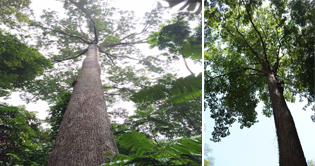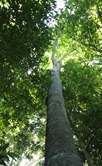Conserving Tropical Forest Giants
Did you know that the world’s tallest tropical tree is a Dipterocarp? Towering over the rest of the forest at an unusual 100.8 metres, a Yellow Meranti (Shorea faguetiana) found in Sabah, Malaysia, was given this title in 2019.
What are Dipterocarps?
The Dipterocarps are a family of hardwood trees that occur in tropical forests across the world. Their stronghold lies in Southeast Asia, where over 500 species have been found. They grow to be some of the tallest trees in the region’s forests and comprise up to 50 to 80% of the forest canopy.
Living up to hundreds of years old, these native trees grow slowly but surely, with some species reaching heights of over 80 m at maturity. The next time you are in a mature forest, take a look up – one of the tallest trees you spot may very well be a Dipterocarp!


Left to right: The Seraya (Shorea curtisii), Keruing Kerut (Dipterocarpus sublamellatus), and Kapur (Dryboanalops aromatica) are examples of mature Dipterocarps.
Importance of Dipterocarps
These mighty giants play a big role in our native forests. Dipterocarps often make up the largest proportion of trees in mature forests, and are among the emergent trees in the canopy. Being so tall and numerous, their presence provides important habitats for animals living in the forest, in addition to producing fruits, pollen, and nectar for them.
Other than being ecologically important, Dipterocarps are also economically significant. They are highly sought-after in the timber industry due to the durability of their wood which is used in construction and furniture. Their oil-rich seeds can be used as a substitute for cocoa butter in cooking and cosmetics. When “wounded”, their trunks secrete resin that is tapped for use in varnishes, essential oils and medicine.
However, many species of these long-lived, slow-growing trees have become Critically Endangered in our region due to deforestation to make way for plantations, or commercial logging for timber.
Distinguishing Features
“Dipterocarp” might sound like a mouthful, but it is actually a reference to the trees’ distinctive fruits. In Greek, “dipteron” means two-winged, and “karpos” means fruit.

Fruits of the Mersawa Merah (Anisoptera megistocarpa)
Photo credit: Ang Wee Foong
These wings spin in a helicopter-like manner in the air, helping the fruits stay longer in the air so as to be dispersed farther away from their parent tree. Still, some Dipterocarps can have fruits that have up to five wings, and some may even be wingless! Instead of being dispersed by wind, these wingless fruits travel by water to find new grounds to establish.
Another special feature of Dipterocarps is their unusual method of reproduction. Once every few years, populations of Dipterocarps in the forest will produce large amounts of fruits all at once, in what is known as “mast fruiting”.
It is thought that this helps to promote the survival of seeds, as the excessive amount of fruits available suddenly is too much for animals to consume completely, leaving some uneaten fruits to form the next generation.
Get Up Close to Dipterocarps
Want to learn more about these precious trees? You can, at the 4-hectare OCBC Arboretum that was opened as part of the Gallop Extension in the Singapore Botanic Gardens in October 2019. Thanks to the support of OCBC Bank, this area will be home to 2,000 trees from over 200 Dipterocarp species. Some of the saplings will grow up to 80 m over time, forming the largest and most diverse Dipterocarp collection in Singapore.

Visit the OCBC Arboretum in the Gallop Extension in the Singapore Botanic Gardens to learn more about dipterocarps, including how researchers are using environmental sensors (right), linked by IoT, to obtain detailed, continuous data on the environmental conditions within the Arboretum.
Featuring an Internet of Things (IoT) system and a unique environmental monitoring system, the OCBC Arboretum is the first of its kind in Southeast Asia to employ such technology in greenery management.
For instance, Light Detection and Ranging (LiDAR) technology will be used to produce high-resolution 3D models of the trees. Multispectral imaging tools will also be used to measure different wavelengths of light reflected off the leaves of the trees. When analysed with real-time data from the IoT sensors on conditions such as soil moisture, these models and measurements can shed light on the conditions required for the healthy growth of various Dipterocarp species, among other tree species.

The use of drones as well as weather station instruments in the OCBC Arboretum help study tree health and the impact of climate respectively.
LiDAR, together with weather station instruments and the use of drones form an Ecological Network of Tree Sensors (ENTS) that study three key components – tree growth, climate and tree health.
These findings will go a long way in supporting the restoration and re-introduction of Dipterocarps to our nature areas and will contribute towards Singapore Botanic Gardens’ role as a world-class botanical garden and a premier research, conservation and botanical institution.
Combating Climate Change
It is important for us to understand the environmental preferences of different species of Dipterocarps. In the face of climate change, such information will help us better manage Dipterocarps in both an urban and forest setting, as well as on a regional platform. For example, the work at the OCBC Arboretum alone may have an impact on climate action as the 2,000 trees can store some 80 million kg of CO2 in their lifetimes.
OCBC Bank’s contribution of S$4m towards this initiative will also include the transformation of Singapore first black and white bungalow into the Forest Discovery Centre @ OCBC Arboretum, a knowledge centre for conservation. This initiative is the most significant addition to OCBC Bank’s partnership with NParks to date. This centre is expected to be opened in 2020.
Learning More

While in the Gallop Extension, you can also hike up the (left) Mingxin Foundation Rambler’s Ridge, a trail that features carnivorous plants like the (left) Raffles’ Pitcher Plant.
Click here for more information on the Gallop Extension at the Singapore Botanic Gardens.
Interested to learn more about the trees that make up our urban forest? Check out trees.sg, our online map which shows the locations of over 500,000 trees, features interesting bites of information on unique tree species, and even lets you show some love to your favourite tree by leaving it a treemail and giving it a hug!
Get up close and personal with some of the trees on our island by going on a walking or cycling trail in our parks, gardens and park connectors. Besides admiring the trees, you can also potentially spot biodiversity. Learn more about going on a DIY walk.
If you would like to contribute to the Singapore Botanic Gardens’ conservation efforts, you can pledge your donation to Give to the Gardens programme through the Garden City Fund here.
If you like what you read, follow us on Facebook, Instagram and Telegram to get the latest updates.
Text by Jolyn Tan





Have views or comments on this article? Let us know via this form. If you would like to give us feedback on any other areas relating to our parks and gardens, please submit via https://www.nparks.gov.sg/feedback